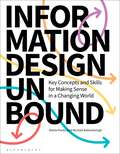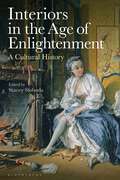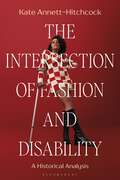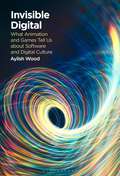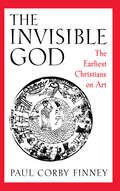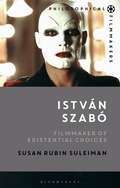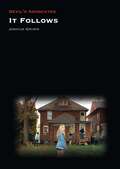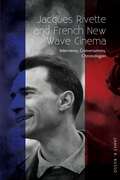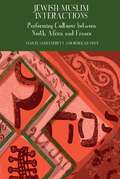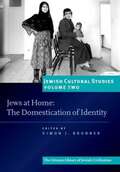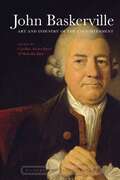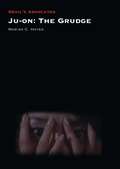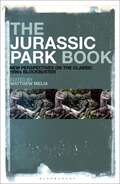- Table View
- List View
Indian Blankets and Their Makers
by George Wharton JamesHistory, old-style wool blankets, changes brought about by traders, symbolism of design and color, a Navajo weaver at work, more. Emphasis on Navajo. Includes information on the Bayeta blanket, squaw dresses, dyeing, belts, garters, hair braids, imitation blankets, the Chimayó blanket, and reliable dealers. 254 illustrations, 32 in color.
Information Design Unbound: Key Concepts and Skills for Making Sense in a Changing World
by Dr Sheila Pontis Michael BabwahsinghAs everyday tasks grow more confusing, and as social and global problems grow more complex, the information designer's role in bringing clarity has reached a new level of importance. In order to have a positive impact, they must go beyond conventional approaches to uncover real needs, make insightful connections, and develop effective solutions. Information Design Unbound provides a clear, engaging introduction to the field, and prepares students to be strategic thinkers and visual problem solvers who can confidently make sense in a changing world.Sheila Pontis and Michael Babwahsingh present a holistic view of information design, synthesizing decades of research, cross-disciplinary knowledge, and emerging practices. The book opens by laying a foundation in the field, first painting the bigger picture of what it is and how it originated, before explaining the scientific and cultural dimensions of how people perceive and understand visual information. A discussion of professional practices, ethical considerations, and the expanding scale of challenges sheds light on the day-to-day work of information designers today. Detailed chapters then delve into the four areas that are integral to all types of information design work: visual thinking, research, sensemaking, and design. The final section of the book puts everything together, with detailed project walk-throughs in areas such as icon design, instructions, wayfinding, organizational strategy, and healthcare system change.Written and designed with students' needs in mind, this book brings information design fundamentals to life: exercises allow students to put lessons directly into practice, case studies demonstrate how information designers think and work, and generous illustrations clarify concepts in a visually engaging way.Information Design Unbound helps beginning designers build the mindset and skillset to navigate visual communication challenges wherever they may arise.
Inside the Westminster Menswear Archive
by Professor Andrew Groves Dr Danielle SprecherInside the Westminster Menswear Archive is a unique guide to the role of garment archives as an industry resource for designers to research and examine both historical garments and the work of their peers.With exclusive access to over 120 key garments from the Westminster Menswear Archive, spanning the last 275 years, each piece is brilliantly photographed in close-up detail and annotated with curator commentary, to inspire new generations of designers.Highlights include garments from: A-COLD-WALL*, Ahluwalia, Aitor Throup Studio, Alexander McQueen, Belstaff, Bernhard Willhelm, Burberry, Casely-Hayford, C.P. Company, Carol Christian Poell, Comme des Garçons, Craig Green, Dior Men, Fred Perry, Helmut Lang, Hussein Chalayan, Jean Paul Gaultier, Junya Watanabe, Louis Vuitton, Martine Rose, Meadham Kirchhoff, Nigel Cabourn, Paul Smith, Prada, Stone Island, Umbro, Undercover, Vexed Generation, and Vollebak.
Inter-Art Journey: Exploring the Common Grounds of the Arts Studies in Honor of Eli Rozik
by Nurit YaariIn recent years, inter-medial studies have attracted increasing attention in arts theory. The notion of 'inter-mediality' presupposes that each established art such as theatre, painting, and cinema indicates the existence of a particular medium, which preserves its distinct features in translations from art to art and, especially, in its combinations with others in single works. Nonetheless, this field of research is presupposed already in the traditional studies of ekphrasis', which focus on the verbal accounts of nonverbal works of art; and in Wagner's notion of Gesamtkuntswerk. This renewed interest generated new fields of research, such as (a) the likelihood of the arts reflecting common grounds; (b) the necessity of a shared metalanguage; (b) the possibility of inter-medial translation; and (d) the inter-medial coexistence within a single work of art, without hindering the reading, interpreting and experiencing abilities of receivers. In honor of Eli Rozik, Ph.D., professor emeritus, former head of the Department of Theatre Studies, and Dean of the Faculty of Arts, Tel Aviv University, this collection provides overviews of all these theoretical issues, and tackles the contemporary practical questions that arise from attempts to transgress the boundaries between the established disciplines of arts studies. Considering first the theoretical aspects of inter-art, inter-mediality, and nonverbal literacy, Exploring the Common Grounds of the Arts goes on to discuss by means of performance analysis; dialogues between the arts within a single work; and correspondences between visual and auditory stimuli in musical contexts. It concludes with a discussion of practical examples of inter-mediality in religious representations, official processions, and public performances.
Interiors in the Age of Enlightenment: A Cultural History
Interiors in the Age of Enlightenment provides a comprehensive and interdisciplinary overview of the cultural history of interior design and interior spaces from 1700 to 1850.Considering the interior as material, social and cultural artefact, this volume moves beyond conventional descriptive accounts of changing styles and interior design fashions, to explore in depth the effect on the interior of the materials, processes, aesthetic philosophies and cultural attitudes of the age.From the Palace of Versailles to Virginia coffeehouses, and from Chinoiserie bathhouses to the trading exchanges of the West Indies, the chapters in this book examine a wide range of themes including technological advancements, public spaces, gender and sexuality, and global movements in interior designs and decorations. Drawing together contributions from leading scholars, this volume provides the most authoritative and comprehensive survey of the history of interiors and interior architecture in the long eighteenth century.
The Intersection of Fashion and Disability: A Historical Analysis
by Kate Annett-HitchcockThe history of the fashion industry has been well written as it relates to people who conform to certain physical norms and cultural stereotypes, whereas the inequality in access to the world of fashion has been largely ignored. Despite this lack of coverage, much work has taken place over the centuries to enable people who live with disability to participate in fashionable culture. This book tells that story via perspectives of notable historical figures, events and movements, and continues the discourse with a look at some of the contemporary developments in clothing and fashion.The Intersection of Fashion and Disability takes the long view, from early attempts to conceal 'unsightly' bodies of royalty and nobility via creative innovation through growing contemporary awareness of inclusive fashion and how future work can be driven by technology and cultural acceptance.
Invisible Digital: What Animation and Games Tell Us about Software and Digital Culture
by Aylish WoodInvisible Digital helps us makes sense of something we cannot see by presenting an innovative approach to digital images and digital culture. At its heart is a novel method for exploring software used in the creation of moving images as markers of converging cultural, organizational and technological influences. The three main case studies of Invisible Digital are the animated feature Moana (2016) and the computer games No Man's Sky (2016) and Everything (2017). All three were created using procedural techniques: simulation software for Moana, and procedural content generation for No Man's Sky and Everything. Production culture disclosures associated with procedural techniques often emphasize the influences of automated systems and their algorithms, making them ideal for a study that interrogates digital processes. The approach of Invisible Digital is informed by relational theories and the concept of entanglement based on materialist perspectives, combined with insights from work that more explicitly interrogates algorithms and algorithmic culture. Aylish Wood employs the notion of assemblages to introduce the concept of material-cultural narratives. Using this conceptual framework, she draws out material-cultural narratives for each case study to demonstrate what they reveal about software and digital culture. These analyses of software provide a widely applicable method through which moving image studies can contribute more fully to the wider and growing debates about algorithmic culture.
The Invisible God: The Earliest Christians On Art
by Paul Corby FinneyThis revisionist study challenges the received opinion that in its earliest manifestations Christianity was a form of religiosity opposed both on principle and in fact to the use of pictures. Paul Corby Finney argues that the well-known absence of Christian pictures before A.D. 200 is due to a complex interplay of social, economic, and political factors, and is not, as is commonly assumed, a result of an anti-image ideology. The book documents the origins of Christian art based on some of the oldest surviving Christian archaeological evidence, and it seeks to show how the Christian products conformed to the already-existing pagan types and models. This study will interest scholars and students in the fields of church history, ancient history, archaeology, art history, classics, and historical theology.
Ireland: The Matter of Monuments
This collection considers Irish monuments from the medieval to the modern era. The essays presented here acknowledge the plurality of values associated with Irish monuments. Taking a holistic approach to the topic, the volume contains contributions from art historians, archaeologists, historians and heritage practitioners. The multidisciplinary and intersectoral contributions are placed in dialogue with one another, providing a discussion of Irish monuments that is unique in its comprehensiveness. The integration of research on early Irish monumental work with that of the more modern period, situating all Irish monuments on a continuum of shared concerns, is a significant pioneering element in this field. The range of perspectives represented in the book reflects the complexity of cultural heritage in contemporary life and opens the conversation to include a wider range of views. It will be a valuable resource for scholars, students, learned societies, public bodies, communities in Ireland and for anyone interested in sculpture. An Open Access version of Kathleen James-Chakraborty's chapter 'New states and old statues: Ireland's monuments in an international context' will be made available on publication.
Ireland: The Matter of Monuments
This collection considers Irish monuments from the medieval to the modern era. The essays presented here acknowledge the plurality of values associated with Irish monuments. Taking a holistic approach to the topic, the volume contains contributions from art historians, archaeologists, historians and heritage practitioners. The multidisciplinary and intersectoral contributions are placed in dialogue with one another, providing a discussion of Irish monuments that is unique in its comprehensiveness. The integration of research on early Irish monumental work with that of the more modern period, situating all Irish monuments on a continuum of shared concerns, is a significant pioneering element in this field. The range of perspectives represented in the book reflects the complexity of cultural heritage in contemporary life and opens the conversation to include a wider range of views. It will be a valuable resource for scholars, students, learned societies, public bodies, communities in Ireland and for anyone interested in sculpture. An Open Access version of Kathleen James-Chakraborty's chapter 'New states and old statues: Ireland's monuments in an international context' is available on the Liverpool University Press website.
István Szabó: Filmmaker of Existential Choices (Philosophical Filmmakers)
by Susan Rubin SuleimanIstván Szabó is one of the few Hungarian filmmakers to have earned a major international reputation over the past half century. This thoughtful and original book is the first examination of Szabó's contribution to contemporary thought, engaging the troubled history of Europe in the 20th and 21st centuries. István Szabó's importance as a filmmaker lies not only in his attention to film's formal elements but in his deep and ongoing engagement with some of the most urgent ethical and existential questions of our time. With detailed analyses of István Szabó's major films, from his 1960s works to his Academy Award for Best Foreign Film winner, Mephisto, and on through Szabó's last film in 2020, Final Report, Susan Rubin Suleiman focuses on four important questions pertaining to existential choice: to leave home or to stay in a communist country? To collaborate or not with an authoritarian regime? To affirm or to deny one's Jewishness in the face of antisemitism? To seek or to give up on community in the face of individual or national conflicts? Above all, Suleiman addresses the single most important philosophical question that haunts Szabó's work, as it does that of many other Central European intellectuals and filmmakers of our time. That is, how do individuals attempt, through the life choices they make or that are foisted on them, to create a viable self in extreme historical situations over which they have no control?
IT Chapters One and Two (Devil's Advocates)
by Alissa BurgerDrawing on critical analysis of film, the horror genre, the Gothic, and Stephen King scholarship, this book considers Andy Muschietti’s IT Chapter One (2017) and IT Chapter Two (2019) on multiple levels: as film (both as individual films and through their interconnected narrative), as adaptation, and as a barometer of the horror film’s popularity among fans. Key points of consideration include the significance of the fictional town of Derry as a traditionally Gothic “bad place,” the role of 1980s nostalgia in these two films, the complex navigation of memory and trauma, gender representation, queer representation, and the return of the repressed. The terrifying figure of Pennywise the clown is central to this analysis, including consideration of performance, costuming, and significance within the larger landscape of the “scary clown” popular culture trope, and through comparison to Tim Curry’s iconic performance in Tommy Lee Wallace’s 1990 miniseries. This Devil's Advocate contextualizes Muschietti’s films within the larger landscape of King’s literary and popular culture influence, as well as the debate surrounding “elevated” horror and the “horror boom” of the late 2010s.
It Follows (Devil's Advocates)
by Josh GrimmAmid a recent resurgence in horror films, David Robert Mitchell’s It Follows stands out as a particularly bold entry, a horror fan’s dream come true that sparked a renewed creativity. Pulling a robust 97% on Rotten Tomatoes, It Follows was hailed as a “teen movie you’ve never seen before,” a “creepy, mesmerizing exercise in minimalist horror,” “the best horror film in years,” and simply, “so damn good.” Mitchell uses a variety of approaches to reinvent genre bromides while simultaneously embracing and challenging tropes that audiences and filmmakers rely on a little too heavily. It Follows is one of the best because it is one of the most unique. In this Devil’s Advocate, Joshua Grimm focuses on how this film helped reinvent the rules of a horror movie, particularly along the lines of genre, style, sex, and gender.
Italy is Out
by Mario BadagliaccaItaly is Out is the fruit of the collaboration between Mario Badagliacca, the established documentary photographer, and the research team of ‘Transnationalizing Modern Languages: Mobility, Identity and Translation in Modern Italian Cultures’ (2014-16). This ARHC-funded project explored the implications of Italian migration in a global perspective tracing cultural transformations across borders, generations, and language. Badagliacca visited some of the project’s key locations conducting interviews with Italians or people of Italian descent before photographing them in familiar locations. The subjects of the portraits were invited to bring along three objects representing their attachment to Italy. The sheer variety of the objects which appear alongside the portraits suggest the diversity of the migrant experience. Photographs shot in London, New York, and Buenos Aires feature members of the historical Italian community, but also first generation migrants in search of opportunities not offered at home. A similar complexity emerges, more unexpectedly, in the postcolonial Italian communities of Tunis and Addis Abeba. The photographs are accompanied by essays written by members of the research team and people who have in some way participated in the project. Fiction, autobiography and academic reflection sit side by side adding to Badagliacca’s multifaceted exploration of Italians abroad.
Jacques Rivette and French New Wave Cinema: Interviews, Conversations, Chronologies
by James R RussoThis first comprehensive English collection of the interviews of Jacques Rivette (19282016) documents his career through chronology, filmography, bibliography, and image stills. A comprehensive introduction places this work in the wider context of twentieth-century social change. Rivettes films, like many of the works of the French New Wave, seem to have avoided the aging process entirely, remaining as playful, fresh, and quietly spectacular as the day they were made. Indeed, his body of work may be the most impressive of the French New Wave. Celine and Julie Go Boating (1974) has been recognized as possibly the best film to emerge from the post-New Wave era, even as Paris Belongs to Us (1961) is one of the best pictures to emerge from the New Wave itself. Rivette was hardly the most prolific director, however, and the length of his films has often counted against him. Nonetheless, his clinical, self-reflexive essays in film form reveal him as a cinematic purist whose commitment to the celluloid muse hardly diminished from the heady days of the early 1950s to the end of his career in 2009. Beyond inspiring the New Wave movement and continuing to reflect, and reflect on, its central tenets, Rivettes enduring contribution to the history of film is unquestionably evident in his sensitive treatment of the histories and destinies of women, especially through strong roles for actresses. During the six decades of his career, nonetheless, he struck a subtle balance not only between female and male characters, but also between political and personal obsession, between myth and fiction, between theater and cinema, in films that, in addition to having influenced such contemporary filmmakers as Claire Denis, Jim Jarmusch, Olivier Assayas, and David Lynch, continue to redefine the art of cinema around the world.
Jamaica Making: The Theresa Roberts Art Collection
This book accompanies the first exhibition entirely of Jamaican art to take place in the north-west of the UK. The exhibition, Jamaica Making: The Theresa Roberts Art Collection, is sited at the Victoria Gallery and Museum, Liverpool in 2022, and is a comprehensive presentation of the best of Jamaican art since the 1960s. The Theresa Roberts Art Collection is the private collection of Theresa Roberts, a Jamaican-born businesswoman and philanthropist, who has made the UK her home. This collection offers an important insight into the development of Jamaican art since the country gained independence in 1962. Indeed, the exhibition also acts to commemorate the 60th anniversary of Jamaican independence in 2022. Included in the book are the following: an official welcome from the Prime Minister of Jamaica; an essay by the collector, exhibition donor and philanthropist, Theresa Roberts; an introduction by eminent British-Jamaican art historian, Edward Lucie-Smith; essays by Emma Roberts, the exhibition curator (Liverpool John Moores University), Davinia Gregory-Kameka, writer, educator and researcher (Columbia University, USA) and Sireita Mullings, arts practitioner and visual sociologist (University of Bedfordshire). The final section of the book is the full visual catalogue of the Jamaica Making exhibition – a unique record of this historic exhibition. An Open Access edition of this book is available on the Liverpool University Press website and the OAPEN library.
Jewish–Muslim Interactions: Performing Cultures between North Africa and France (Francophone Postcolonial Studies #11)
By exploring dynamic Jewish-Muslim interactions across North Africa and France through performance culture in the 20th and 21st centuries, we offer an alternative chronology and lens to a growing trend in media and scholarship that views these interactions primarily through conflict. Our volume interrogates interaction that crosses the genres of theatre, music, film, art, and stand-up, emphasising creative influence and artistic cooperation between performers from the Maghrib, with a focus on Algeria, Tunisia, Morocco, and diaspora communities, notably in France. The plays, songs, films, images, and comedy sketches that we analyse are multilingual, mixing not only with the former colonial language French, but also the rich diversity of indigenous Amazigh and Arabic languages. The volume includes contributions by scholars working across and beyond disciplinary boundaries through anthropology, ethnomusicology, history, sociology, and literature, engaging with postcolonial studies, memory studies, cultural studies, and transnational French studies. The first section examines accents, affiliations, and exchange, with an emphasis on aesthetics, familiarity, changing social roles, and cultural entrepreneurship. The second section shifts to consider departure and lingering presence through spectres and taboos, in its exploration of absence, influence, and elision. The volume concludes with an autobiographical afterword, which reflects on memories and legacies of Jewish-Muslim interactions across the Mediterranean. Contributors: Cristina Moreno Almeida, Jamal Bahmad, Adi Saleem Bharat, Aomar Boum, Morgan Corriou, Ruth Davis, Samuel Sami Everett, Fanny Gillet, Jonathan Glasser, Miléna Kartowski-Aïach, Nadia Kiwan, Hadj Miliani, Vanessa Paloma Elbaz, Elizabeth Perego, Christopher Silver, Rebekah Vince, Valérie Zenatti
Jews at Home: The Domestication of Identity (Jewish Cultural Studies #2)
by Simon J. BronnerFor a Jew, describing a place as 'home' conveys connotations of heritage as well as of residence. Additionally, feeling 'at home' suggests a sense of comfort in one's social surroundings. The questions at the heart of this volume are: what things make a home 'Jewish', materially and emotionally, and what is it that makes Jews feel 'at home' in their environment? The material dimensions are explored through a study of the symbolic and ritual objects that convey Jewishness and a consideration of other items that may be used to express Jewish identity in the home-something that the introduction identifies as 'living-room Judaism'. The discussion is geographically and ethnically wide-ranging, and the transformation of meaning attached to different objects in different environments is contextualized, as, for example, in Shalom Sabar's study of {h.}amsa amulets in Morocco and Israel. For diasporic Jewish culture, the question of feeling at home is an emotional issue that frequently emerges in literature, folklore, and the visual and performing arts. The phrase 'at-homeness in exile' aptly expresses the tension between the different heritages with which Jews identify, including that between the biblical promised land and the cultural locations from which Jewish migration emanated. The essays in this volume take a closer look at the way in which ideas about feeling at home as a Jew are expressed in literature originating in Brazil, Argentina, and the United States, and also at the political ramifications of these emotions. The question is further explored in a series of exchanges on the future of Jews feeling 'at home' in Australia, Germany, Israel, and the United States. Jews at Home is the first book to examine the theme of the Jewish home materially and emotionally from a variety of disciplinary perspectives, including literature, history, anthropology, sociology, psychology, art history, and folk and popular culture. The essays in the collection use the theme of home and the concept of domestication to revise understanding of the lived (and built) past, and to open new analytical possibilities for the future. Its discussion of domestic culture and its relevance to Jewish identity is one with which readers should feel right at home.
John Baskerville: Art and Industry in the Enlightenment (Eighteenth-Century Worlds #7)
by Caroline Archer-Parré Malcolm DickThis book is concerned with the eighteenth-century typographer, printer, industrialist and Enlightenment figure, John Baskerville (1707-75). Baskerville was a Birmingham inventor, entrepreneur and artist with a worldwide reputation who made eighteenth-century Birmingham a city without typographic equal, by changing the course of type design. Baskerville not only designed one of the world’s most historically important typefaces, he also experimented with casting and setting type, improved the construction of the printing-press, developed a new kind of paper and refined the quality of printing inks. His typographic experiments put him ahead of his time, had an international impact and did much to enhance the printing and publishing industries of his day. Yet despite his importance, fame and influence many aspects of Baskerville’s work and life remain unexplored and his contribution to the arts, industry, culture and society of the Enlightenment are largely unrecognized. Moreover, recent scholarly research in archaeology, art and design, history, literary studies and typography, is leading to a fundamental reassessment of many aspects of Baskerville’s life and impact, including his birthplace, his work as an industrialist, the networks which sustained him and the reception of his printing in Britain and overseas. The last major, but inadequate publication of Baskerville dates from 1975. Now, forty years on, the time is ripe for a new book. This interdisciplinary approach provides an original contribution to printing history, eighteenth-century studies and the dissemination of ideas.
John Outram (Twentieth Century Architects)
by Geraint FranklinThis is the first major study of John Outram, whose decorative yet elemental architecture has captured the popular imagination. Outram launched his own architectural practice in 1974, soon securing a reputation for innovative, creative and monumental buildings. Their brilliant colours and exuberant gestures earned him a reputation as a post-modernist, but this book explores their deeper background in architectural history, metaphysics and mythology. In addition to the major buildings – including The New House at Wadhurst, the Isle of Dogs Pumping Station and the Judge Institute – the book examines unrealised projects, including Bracken House and Ludgate in the City of London. Running through them all is a storytelling approach that draws upon the mythologies and architectures of the ancient world. This book shows how Outram’s work reconciles iconography with a creative approach to building technology, posing questions about the recovery of architecture’s traditional role of communicating shared values. Geraint Franklin draws on interviews and archival research to shed new light on this important architect. Richly illustrated with previously unpublished images from the practice archive and stunning new photography, the book will delight architects, students and anyone interested in learning more about this significant figure in late 20th century architecture.
Ju-On: The Grudge (Devil's Advocates)
by Marisa HayesTakashi Shimizu's Ju-on franchise was a principal instigator in the rise of contemporary Japanese horror and its international popularity at the turn of the millennium. Following the success of Hideo Nakata's Ringu (1998), the first cinematic release of Ju-on: The Grudge in 2002 crystallized Japanese horror's rise to prominence and outlined the new decade's thematic interest in supernatural technology and fear of contagions, while skillfully navigating domestic social concerns, such as Japan's growing elderly population and domestic violence.This Devil's Advocate explores the production roots of Ju-on The Grudge, followed by a critical reading of the film that highlights its essential themes and motifs, in addition to a section on cultural influences, before concluding with a section on Shimizu's continued involvement with the Ju-on franchise and its ongoing legacy. The book serves as an excellent primer for readers without prior knowledge of Japanese horror or the Ju-on film cycle, while providing fresh perspectives on the film that makes it equally appealing to J-horror aficionados.
The Jurassic Park Book: New Perspectives on the Classic 1990s Blockbuster
The definitive 1990s blockbuster, Steven Spielberg's Jurassic Park met with almost universal critical and popular acclaim, broke new ground with its CGI recreation of dinosaurs, and started one of the most profitable of all movie franchises. To mark the film's 30th anniversary, this exciting illustrated collection of new essays interrogates the Jurassic Park phenomenon from a diverse range of critical, historical, and theoretical angles. The primary focus is on Jurassic Park itself but there is also discussion of the franchise and its numerous spin-offs.As well as leading international scholars of film studies and history, contributors include experts in special effects, science on screen, fan studies, and palaeontology. Comprehensive, up to date, and accessible, The Jurassic Park Book appeals not only to students and scholars of Hollywood and contemporary culture, but also to the global audience of fans of the greatest of all dinosaur movies.
Just Brick It: Over 20 Projects for Adult Fans of Lego
by David ScarfeJust Brick It is a fun Lego construction book for adults, showing you how to build impressive, quirky and hugely appealing objects using the bricks we all know and love. Made up of 20 different projects, including objects for the home and holiday decorations, as well as stylish art and design ideas, this is a fun, practical and gloriously silly guide. Detailed yet easy-to-follow instructions will guide you through each step, so that you too can build your own Lego masterpieces. This hugely entertaining yet challenging book proves that Lego is most definitely not just for kids!
Kantha: Sustainable Textiles and Mindful Making
by Ekta KaulA beautiful book on the tradition of kantha, a Bengali embroidery technique with a rich heritage rooted in storytelling and upcycling, with inspiration and techniques for contemporary makers.The word 'kantha' refers to both the style of running stitch, as well as the finished cloth: quilted textiles made from multiple layers of cast-off cloth, traditionally embroidered with threads pulled out from the borders of old saris and dhotis. These beautiful fabrics were created exclusively by women in the Bengal region of the Indian subcontinent.In this richly illustrated book, textile artist Ekta Kaul explores the history of the kantha tradition and finds objects of extraordinary beauty. She goes on to look at how the kantha spirit is inspiring artists today and discusses creative techniques to help you develop your own interpretations, alongside a dictionary of fundamental kantha stitches with supporting images and instructions.Steeped in the ethos of sustainability, emotional repair and mindful making, kantha will lead you to uncover a slower and more thoughtful approach to stitching.


